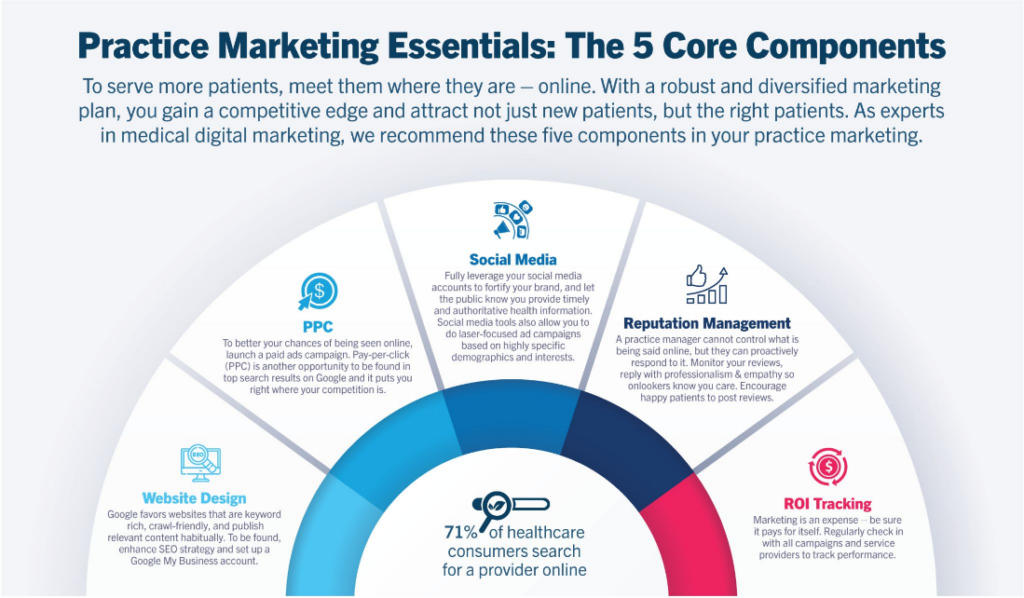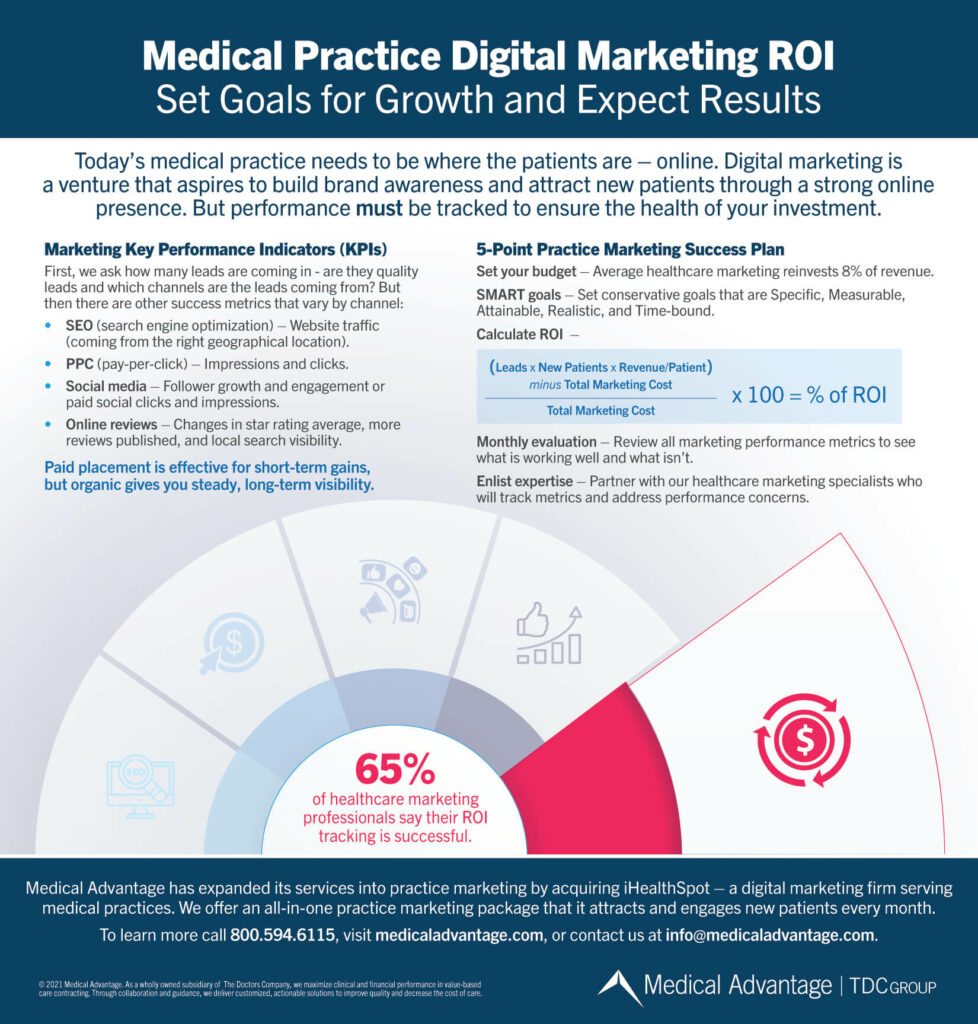Practice Marketing Return on Investment Indicators
Step 1 – Set your spending budget
Step 2 – Set SMART goals (mix of # leads per month and brand awareness KPIs)
Step 3 – Understand basic ROI calculations
Step 4 – Consult with experts
Step 5 – Routine Follow-Ups
Include Patient Lifetime Value as an ROI Factor
Practice Marketing Essentials Series: Practice Marketing ROI
Just as medical practice staff would surely notice if supply orders never arrived, healthcare management should expect something to show for money spent on marketing. Peripheral operations like marketing can sometimes be forgotten in the shuffle of a busy clinic, but like anything else, a marketing budget for healthcare management is an essential part of making your spend count.
Because of the pandemic, medical practices across the country saw sharp losses in revenue and healthcare jobs in 2020 – not to mention the added cost of COVID-19 safety supplies. For this reason, many clinics are tightening their belts and being more mindful about certain expenses as with marketing budgets for medical practices.
Marketing spend is a core component of any healthcare operations budget, as it is needed to generate revenue and remain competitive. But just because marketing spending is a requisite does not mean practices should fund it indiscriminately. Performance must be tracked to confirm that the marketing provides value and vitality to a medical practice.

Practice Marketing Return on Investment Indicators
How do you know if practice marketing efforts are working? There are the obvious indicators – more new patient appointment requests or incoming phone calls. But where digital marketing is involved, you have the gift of data (something analog advertising cannot easily track) that provides more conclusive evidence. These next few sections explain how to assess practice marketing performance.
Tracking Qualified Leads
The purpose of marketing is to capture leads, but simply counting how many leads come in does not quantify the success of a campaign. Effective marketing should attract those most likely to complete an appointment.
To understand the quality of the leads that are coming through, you would sort them out. For example, some appointment request form submissions may indicate a lack of intention to schedule such as giving phony contact information. Are several leads being turned away because they do not meet certain criteria? When too many unqualified leads are coming in, it is time to fine tune the process with measures such as better ad targeting and making changes to the appointment request form.

Tracking Where Leads Are Coming From
As mentioned above, an uptick in new patient appointments is a huge hint that the marketing is working, but it is important to know what brought them through your doors.
Asking patients directly is one way to determine how they found you. This can be done either in the appointment request form, verbally, or in the new patient paperwork.
The covert approach to know where leads are coming from is digital tracking. For example, unique tracking links connect to your appointment request form designated by paid search (such as a Google Ad), paid social (such as a Facebook ad), or direct traffic (organic or “branded” search). This way you can track how many leads each channel yields.
Tracking Brand Awareness
The marketing industry estimates that it takes about eight “touchpoints” to make a “sale,” and the same is likely true for getting a new patient in for a visit. Not all conversions (when a site visitor becomes a new patient) happens in a day.
Thanks to data, marketers can track how many people saw your ads (known as impressions) or visited your website (traffic). Website traffic data can also distinguish new visitors versus repeat visitors in addition to how much time they spend looking around your site.
Impressions and traffic are not an immediate return, but they are seeds planted in the minds of potential patients who may eventually come back around to schedule an appointment.
Examples of KPIs (Key Performance Indicators for Digital Marketing Channels)
Each type of digital marketing has its own success metric:
- SEO (search engine optimization) is being found in search without paying for preference – Web traffic
- PPC (pay per click) is being found in search via paid campaigns – Impressions, clicks, appointments booked from paid traffic.
- Social media marketing is paid and unpaid – Follower growth and engagement (unpaid), clicks and impressions (paid).
- Reputation management builds up reviews – Increased star rating average, and being found in local search.
All channels of marketing work together to build your brand and digital presence to help you remain competitive and bring in new patients. Evaluating each component of marketing ensures the health of these initiatives as a whole.

Step by Step Guide to Ensure Practice Marketing ROI
Marketing spend is an investment, and investments come with risk. However, with wisdom and foresight, wasted funds can be mitigated.
Step 1 – Set your spending budget
To avoid overspending on marketing, limits must be set with a sensible budget. Healthcare marketing spend estimates vary by source, but according to a recent survey of those in the healthcare industry, nearly 8% of an operations budget is earmarked for marketing and 8% of revenue is reinvested in marketing.
Setting a marketing budget for medical practice according to revenue is a practical approach to marketing, as you spend within your means and then invest more when marketing prospers.
Step 2 – Set SMART goals (mix of # leads per month and brand awareness KPIs)
It is best to set clear intentions of what you want your marketing investment to achieve. Those you enlist to execute the marketing will be better guided when given a specific goal to work toward. Your targets can be a blend of the number of qualified leads you hope to acquire per month and how much you would like to increase awareness of your medical practice.
The handy SMART goals tool helps set marketing goals:
Specific and Measurable: How many leads, impressions, likes, follows, social media post engagement metrics per month would make a difference?
Attainable and Realistic: Based on past performance and sound judgment, do these aspirational figures seem within reach?
Time-bound: How much time is needed to reach these goals? When do you expect to see results?
Your practice staff and marketing partners can work together to form these goals.
Practice marketing gains come in the form of both new patient acquisition and increased brand awareness.
Step 3 – Understand basic ROI calculations
One fundamental metric of marketing performance is the cost-per-lead – the grand total of marketing spend is divided by the grand total of leads.
While new patient acquisition does confirm the success of marketing, it should be weighed against the total cost to determine the actual gains.
Perhaps you know of a more sophisticated method of calculating return on investment, but for demonstration purposes, we borrow a generic template. For this you need:
- How many qualified leads were captured?
- How many leads converted (booked and completed an appointment)?
- How much revenue was generated per conversion?
- What was the total cost of marketing?
Then we plug those numbers into this simple ROI formula:
[((number of leads X number of new patients acquired X amount of revenue per patient) – total marketing cost) ÷ total marketing cost] x 100 = % of ROI
So, for healthcare marketing, what is a good ROI? 5:1 is considered a good ROI while below 2:1 is breaking even meaning there is no return from the investment.

Step 4 – Consult with experts
Perhaps there are a few staff members you have in mind to manage your marketing initiatives, but do they have other significant responsibilities? If so, marketing is at risk of being pushed aside when more urgent matters arise, which means practice growth plans will not have a chance to gain traction. Marketing experts would say that building a brand and attracting patients is a full-time undertaking.
Once you have your marketing budget for a medical practice set, and specific results in mind, you are prepared to sit down with experienced marketers and discuss practice growth strategy. Questions to ask when considering a marketing agency are:
- Does this agency have substantial experience with healthcare and medical practices?
- What is the track record of success with this agency?
- What all are you getting from my monthly retainer?
- What is done for the sake of transparency and accountability?
- What adjustments can be made if practice goals are not being met and we are not seeing ROI?
Step 5 – Routine Follow-Ups
Before agreeing to move forward with any marketing initiatives or payment for marketing services, there should be an agreement about how and when performance reports will be shared. Reporting should happen at least once per month, and they should include the same information each time with full transparency.
Marketing partners and stakeholders should be prepared to answer any questions you have about these reports and offer solutions to correct areas of poor performance.
In-house staff also plays a role in maximizing ROI. Marketing can bring in plenty of leads, but there is no revenue to be had until services are rendered. Once marketing garners qualified leads, practice staff must be diligent to follow up with each lead and make efforts to bring them in for an appointment. This consists of both convenient scheduling and appointment reminders.
Real Examples of the Effects Practice Marketing
To give an idea of how marketing spend generates revenue from conversions, we use two of our clients as examples. Each marketing budget for a medical practice brings in new leads consistently each month with medical provider pay-per-click advertising.
One monthly budget was set for $600 per month and nets about 14 conversions per month. Another client spends $5,000 per month and brings in around 200 new patient leads per month. With PPC, the more you spend, the more leads you are likely to generate – , but no matter the amount, campaigns should be calibrated to bring in the most new patients.
Include Patient Lifetime Value as an ROI Factor
Pulling reports monthly typically only looks at short-term revenue gains. Patients will return for follow-up appointments and schedules visit as new needs arise. To get a more accurate assessment of marketing results, the lifetime value of patients should also be factored in.
For a hypothetical example, a clinic’s patients come in for an average of three visits per year with each appointment billing at about $200. After crunching some numbers, the practice management determines that their patient population receives specialty care for an average of four years. Therefore, the estimated lifetime value of a patient is $2,400 in revenue.
Medical Advantage is Committed to Practice Marketing ROI + Maximum Lifetime Value
Marketing should grow your practice rather than squander revenue. To give you the best value for your marketing spend, our medical practice digital marketing experts design a strategy to realize your goals while replicating tried and true methods.
There are thousands of digital marketing agencies out there, but most of them do not have healthcare expertise. Because we only work with medical operations, our marketing experts know to generate practice growth in the healthcare market.
On the practice operations side, our healthcare consultants maximize your return on patient acquisition costs by cultivating patient lifetime value with effective patient retention strategies. Make a plan to grow your practice with a free consultation – fill out the form below today.



